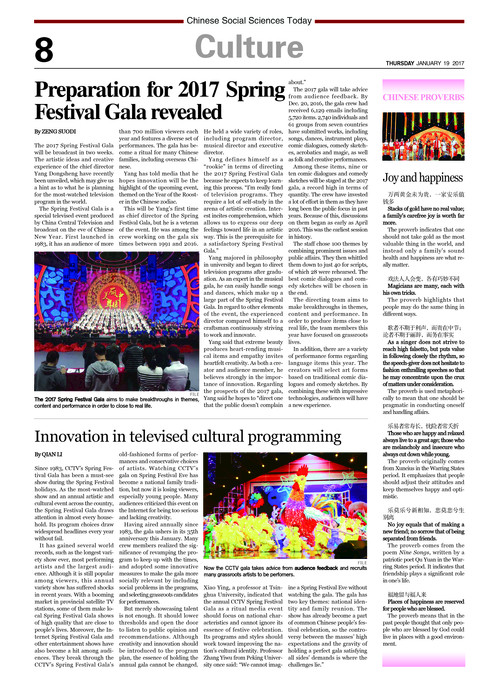Innovation in televised cultural programming
Now the CCTV gala takes advice from audience feedback and recruits many grassroots artists to be perfomers.
By QIAN LI
Since 1983, CCTV’s Spring Festival Gala has been a must-see show during the Spring Festival holidays. As the most-watched show and an annual artistic and cultural event across the country, the Spring Festival Gala draws attention in almost every household. Its program choices draw widespread headlines every year without fail.
It has gained several world records, such as the longest variety show ever, most performing artists and the largest audience. Although it is still popular among viewers, this annual variety show has suffered shocks in recent years. With a booming market in provincial satellite TV stations, some of them make local Spring Festival Gala shows of high quality that are close to people’s lives. Moreover, the Internet Spring Festival Gala and other entertainment shows have also become a hit among audiences. They break through the CCTV’s Spring Festival Gala’s old-fashioned forms of performances and conservative choices of artists. Watching CCTV’s gala on Spring Festival Eve has become a national family tradition, but now it is losing viewers, especially young people. Many audiences criticized this event on the Internet for being too serious and lacking creativity.
Having aired annually since 1983, the gala ushers in its 35th anniversary this January. Many crew members realized the significance of revamping the program to keep up with the times, and adopted some innovative measures to make the gala more socially relevant by including social problems in the programs, and selecting grassroots candidates for performances.
But merely showcasing talent is not enough. It should lower thresholds and open the door to listen to public opinion and recommendations. Although creativity and innovation should be introduced to the program plan, the essence of holding the annual gala cannot be changed. Xiao Ying, a professor at Tsinghua University, indicated that the annual CCTV Spring Festival Gala as a ritual media event should focus on national characteristics and cannot ignore its essence of festive celebration. Its programs and styles should work toward improving the nation’s cultural identity. Professor Zhang Yiwu from Peking University once said: “We cannot imagine a Spring Festival Eve without watching the gala. The gala has two key themes: national identity and family reunion. The show has already become a part of common Chinese people’s festival celebration, so the controversy between the masses’ high expectations and the gravity of holding a perfect gala satisfying all sides’ demands is where the challenges lie.”



